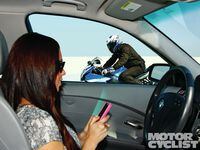There I was, minding my own business in the carpool lane while riding to work one morning, when all hell broke loose in front of me. As traffic slowed suddenly, a young woman driving a sedan in the adjacent lane failed to take notice until the last possible instant. Startled, she stomped on the brakes and swerved to her left—into my lane—yet still managed to tag the mini-van in front of her. There was a loud thud. Smoke poured off of tires. Bits of plastic flew. And both vehicles came to rest against the center divider.
Because I was paying attention—and not going faster than I could stop, despite having had a clear lane in front of me—I was able to steer around the wreckage. Sure enough, as I passed the offender, I could see that she was clutching her cell phone.
A few days later, I was driving my van with a dirtbike in back when a similar scenario unfolded right in front of me. Traffic slowed suddenly, and a middle-aged mom driving an SUV in the adjacent lane failed to take notice until it was too late. She wasn’t quite as fortunate as the young woman, and slammed into the back of the pickup truck in front of her at speed. Her SUV slewed to the left—again, into my lane—and she overcorrected, steering hard to the right. Predictably, the SUV rolled over onto its roof, exploding all of its windows, and then back onto its wheels, whereupon it shot across three lanes of traffic and plowed into an earthen bank. Miraculously, the driver didn’t hit any other vehicles and appeared not to be seriously injured. I wasn’t close enough to see if she had been texting, but judging by her failure to slow when everyone else did, she obviously hadn’t been paying attention. I told the police as much when I called 9-1-1.
There’s been a lot of talk in the media lately about distracted driving, but before I witnessed these two events myself, I didn’t fully grasp the magnitude of the epidemic. The most I had seen were text-messagers “driving by Braille”—swerving from one side of their lane to the other as their tires bounced off the Botts’ dots—plus the obvious after-effects of such collisions, which in Hell A’s notorious freeway commuter traffic, I saw a lot.
When kids started texting a few years ago, I initially thought it was cool. They're actually learning to spell, and to type, my inner editor told me. Then I found out that they weren't typing actual words—it was this bizarre form of shorthand using acronyms. And then they started texting each other while driving, which is downright dangerous.
When motorists began talking on their cell phones, safety experts cautioned that the practice was as dangerous as driving under the influence of alcohol—and it didn't matter whether they were using a hands-free system or not. Well, I'd argue that texting while driving is even more dangerous—at least drunks are looking where they're going!
Try this at home: Time how long it takes you (or your spouse, or child) to type an oft-used text message. “On my way home” took me 15 seconds from New Message to Send. If I had done that while driving at 60 mph, I’d have covered a quarter-mile. That’s way too long to be taking your eyes off the road—and many text messages take much longer.
Why does this matter to motorcyclists? We’re not going to be texting while in motion, right? No, but we share the roads with motorists who do. And unlike the hapless drivers whose cars got rear-ended in the accidents I witnessed, we’d be unlikely to emerge from such a collision unscathed.
How ironic is it that as motor vehicles have become safer than ever due to technological advancements such as anti-lock brakes and traction control, another form of technology is making the roadways more dangerous? Except, like the gun advocates say, it isn't the hardware that kills—it's the people.
With apologies to Pogo, “We have seen the enemy. And he is us.”











/cloudfront-us-east-1.images.arcpublishing.com/octane/HXOUJXQWA5HBHGRO3EMJIGFMVI.jpg)

/cloudfront-us-east-1.images.arcpublishing.com/octane/3TIWWRV4JBBOLDVGRYECVVTA7Y.jpg)
/cloudfront-us-east-1.images.arcpublishing.com/octane/KIX5O23D5NAIBGFXBN3327DKZU.jpg)
/cloudfront-us-east-1.images.arcpublishing.com/octane/7GJYDUIPXRGMTMQKN6ONYOLBOU.jpg)
/cloudfront-us-east-1.images.arcpublishing.com/octane/MUQLOVLL2ZDGFH25ILABNBXKTI.jpg)
/cloudfront-us-east-1.images.arcpublishing.com/octane/TNOU5DNE2BC57MFPMGN2EIDXAM.jpg)
/cloudfront-us-east-1.images.arcpublishing.com/octane/GTCXACQGJ5HAPDTGWUQKDEH44E.jpg)
/cloudfront-us-east-1.images.arcpublishing.com/octane/S35YGSEMEZB4BLTDJTSZPF4GLA.jpg)
/cloudfront-us-east-1.images.arcpublishing.com/octane/5UOT6HPX2JFMRJAX6EH45AR4MQ.jpg)
/cloudfront-us-east-1.images.arcpublishing.com/octane/OKWOJWAKP5EP3OACCRRWPCIX2Q.jpg)
/cloudfront-us-east-1.images.arcpublishing.com/octane/2WF3SCE3NFBQXLDNJM7KMXA45E.jpg)
/cloudfront-us-east-1.images.arcpublishing.com/octane/G4MG6OUCJNBSHIS2MVVOTPX65E.jpg)
/cloudfront-us-east-1.images.arcpublishing.com/octane/IIGGWFOTOJGB7DB6DGBXCCMTDY.jpg)
/cloudfront-us-east-1.images.arcpublishing.com/octane/QSTCM6AVEZA5JJBUXNIQ3DSOF4.jpg)
/cloudfront-us-east-1.images.arcpublishing.com/octane/U4I7G625B5DMLF2DVIJDFZVV6M.jpg)
/cloudfront-us-east-1.images.arcpublishing.com/octane/B6XD6LS6IVCQPIU6HXDJSM3FHY.jpg)
/cloudfront-us-east-1.images.arcpublishing.com/octane/ICL63FEDDRDTTMINYICCEYGMDA.jpg)
/cloudfront-us-east-1.images.arcpublishing.com/octane/FCGZHQXRBZFLBAPC5SDIQLVF4I.jpg)
/cloudfront-us-east-1.images.arcpublishing.com/octane/WNOB6LDOIFFHJKPSVIWDYUGOPM.jpg)

/cloudfront-us-east-1.images.arcpublishing.com/octane/X33NU3E525ECRHXLNUJN2FTRKI.jpg)
/cloudfront-us-east-1.images.arcpublishing.com/octane/6KKT5NNL2JAVBOXMZYS5ZO76YA.jpg)
/cloudfront-us-east-1.images.arcpublishing.com/octane/J5RKG5O455GMPGQRF2OG6LRT7A.jpg)